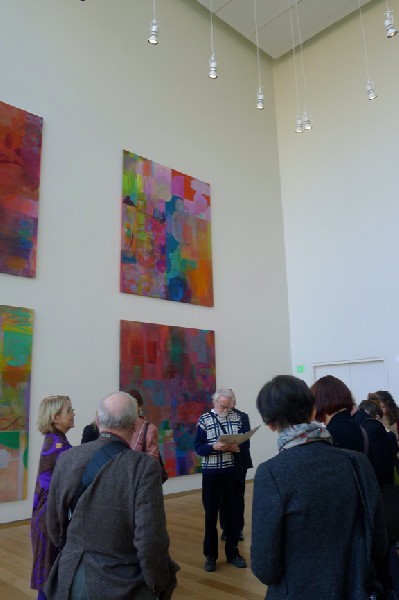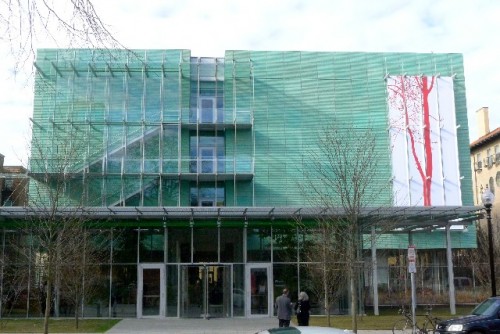Pieranna Cavalchini Lets Artists Think, Explore at the Gardner
The Gift of Time
By: David Bonetti - Jan 22, 2012
Despite the nearly palpable excitement flowing around her during one of the Gardner Museum’s crowded member preview days, Pieranna Cavalchini, the Gardner’s curator of contemporary art, is an island of serenity. Seated on one of the comfortable white-upholstered sofas in the Living Room, a casual glass-walled lounge just beyond the entrance of the new $114 million Renzo Piano-designed addition to the museum, she seems quite pleased with the way things are going, and has every reason to be happy.
The handsome room we are chatting in is in fact part of her program. In 2000, artist-in-residence Lee Mingwei turned the old special exhibition gallery, a tight windowless space squeezed into what had been a museum back office, into a living room.
Inspired by what he had read about Isabella Stewart Gardner’s hospitality, he made the room a comfortable place in which to sit down and hang out, a version of the relational aesthetics that were trendy at the time. During the hours he was in attendance, he showed objects of interest and served tea, engaging visitors in conversation.
When it came time to create an addition that would relieve the old building - now being called “the Palace” - of ancillary functions like the café and shop that are obligatory in contemporary museums, as well as creating a new Concert Hall and Special Exhibition Gallery, the idea of Lee’s living room was recreated and given Capital-Letter prominence.
In addition to serving as a traditional orientation room for the expanded museum with museum catalogs, timelines and touch-screen histories, the Living Room will from time to time host Lee and other artists and connoisseurs to show prized possessions and talk about them with visitors. Tea will be served. Lee has also installed two birdcages with songbirds to bring a living presence to the plant-filled space.
And Stefano Arienti, another of the four artists featured during the opening months, has spread open a thick bound drawing book on a counter to display his work and invite visitors to add their own drawings to the empty pages.
Whether the Living Room takes off as an active center of creativity and artistic exchange remains to be seen, but it’s indicative of the fresh-thinking Cavalchini has brought to her program. And behind the Buddha-like smile, Cavalchini admits to being “very excited” about the expanded possibilities the new addition gives her to present contemporary art.
“This summer we are going to transform the Gallery into a black box and present a short film and animation series,” Cavalchini says. “And in the fall we’ll be showing work by the RAQS Media Collective. They’re based in Delhi and were in residence here a few years ago.
They took what we call ‘the flashlight tour,’ a walk through the museum at night when the only light comes from a flashlight, and they were taken with the idea of perception and light and how objects speak in different cultures. They are going to try to recreate that experience of discovery, playing with darkness and light, in their installation.
“We can put on one-act plays, host poetry readings, even present a small ballet. There are so many possibilities we have with the new building and gallery.”
Performance art is also a possibility. Cavalchini recounts how the pioneering media artist Joan Jonas, who teaches at MIT, worked with her students at the museum, investigating Isabella Gardner’s interest in Dante. “The work that came about, ‘The Dante Project,’ was presented at Performa in New York, at the Venice Biennale and here at the Gardner, each time slightly different.”
Cavalchini wanted the inaugural exhibition in the Gallery, a 36-foot cube with a window wall that offers a breathtaking view of the Palace’s rear elevation and the city beyond, to be a painting show, because the Gardner collection is so identified with painting. (The ceiling is adjustable to 24 and 12 feet heights.)
For the honor, she chose Victoria Morton, a Scot, whose color-based abstractions benefit from the changing light in the spectacular space. “Tapestry (Radio On)” is her first solo museum show in America.
Morton is also a musician, and her Glasgow-based band Muscles of Joy played in the Concert Hall during the opening week festivities. By choosing her, Cavalchini chose an artist who practices in Isabella Gardner’s two primary areas of interest – painting and music.
“The Gardner collection is so rich, the environment so dense, there are so many layers, it’s almost a micro-climate made of layers of art,” Cavalchini says. “It offers a very interesting place for artists to work, to immerse themselves in these collections and archives, to explore.”
Sometimes it might seem to be too much. Cavalchini says that Morton’s first reaction was that the museum was “too ostentatious,” that everything was “too opulent,” but that in the end “she loved the fact that Gardner had the courage to create her own environment.”
Was Isabella Gardner an artist? “She was a very creative individual,” Cavalchini says. “Yes, I think you can call her an artist. She liked artists, she wanted to spend her time with artists. She asked them to help her find work for her collection.”
Of course, even though there have been artists-in-residence at the Gardner since director Anne Hawley initiated the program 20 years ago soon after the famous theft that to many at the time seemed to be the death of the museum, many people are surprised to discover that a museum that seems so dedicated to the art of the past should show new art by living artists.
The standard explanation is that Isabella Gardner was a patron of the artists of her time – John Singer Sargent, James McNeill Whistler, Anders Zorn, all of whom painted her portrait, and a number of Bostonians like Dennis Miller Bunker, Joseph Linden Smith, Denman Ross and Ralph Curtis – and that on one of his several painting trips to Boston, Sargent used the Palace’s Gothic Room as his studio, becoming in effect the museum’s first artist in residence.
Cavalchini, who has directed the program for 10 years, doesn’t waste any time rehearsing that old story, saying instead, “For a lot of people, the new building will make that an old question.”
Cavalchini shares the Gallery with two other curators, Oliver Tostmann, the new collections curator (who will reveal his hand in February 2013 with the exhibition, “Anders Zorn: A European Artist Seduces America,” focusing on work Zorn made from 1890 into the early 20th century), and Charles Waldheim, the consulting curator of landscape (the only - landscape architecture curators associated with an American museum).
But one space will be all Cavalchini’s – the space on the building façade dedicated to changing exhibitions of contemporary art. Inaugurating the space is Italian artist Stefano Arienti, who as resident artist here in 2004 created a drawing installation about the Gardner’s dismantled Chinese Room.
Now, Arienti has made a great banner, 34 feet high by 16 wide, of the silhouette of a bright red Ailanthus tree on a white ground. A non-logo logo, the image might be a form of sly criticism of the Gardner’s celebrated preciousness.
The Ailanthus tree is an urban weed that grows in forsaken tenement courtyards and in back alleys. Whatever his intention, it offers a cheery welcome to the new building. After six months, it will be changed for another Arienti banner. After that, other artists, whom Cavalchini cannot name – “I haven’t asked them yet!” - will take over.
Cavalchini’s explanation of why she chose Arienti for the first project reveals the practicality that often determines such commissions. “I saw an installation Stefano created in a huge exhibiion space in Milano called the Bicoccoa Hangar. It was quite successful. When I had to commission the work for the Gardner, the Piano Workshop had not determined the final dimensions of the space, and I wanted someone who had demonstrated the ability to work at such a large scale in a public space. I didn’t want to take a risk on someone untested.”
I ask Cavalchini what she looks for in an artist to work at the Gardner. “I look for artists working with different languages, with different materials. Heather Ackroyd and Dan Harvey, among the first I invited, responded to the courtyard and its plantings. One of their pieces (a text from Dante imprinted in a panel of living grass) is in the small gallery in which I have brought together small works by about 20 of the artists who have worked here over the years.
“Artists usually respond to something in the museum, but it can take any form. The Croatian artist Danijel Zezelj, for instance, is a graphic novelist, and you might ask what connection that has with Isabella Gardner and her collection, but we live in the present and graphic novels are an art form of the present, so why shouldn’t we present such work?
Anyway, he created a story about a museum closed and blacked-out in wartime in which staff members live, which was set in an unnamed museum that looked like the Gardner, so despite its medium and the apocalyptic tone of the work, in the end it referred back to his residency here.”
Cavalchini seems taken aback when I suggest that most of the artists she has chosen operate under the radar of the larger art world. “Well,” she says, “when I chose Dayanita Singh (who made beautifully evocative photographs of chairs in the museum), she was not known outside a small number of people, and now she is something of a celebrity, especially in India. She came here at the right time.
“I also love to bring in great, established artists,” she quickly adds. “We invited Joseph Kosuth to make an important piece (about the connections of Isabella Gardner, Bernard Berenson and Whistler), and we invited Sol Lewitt to make what turned out to be one of his final wall drawings for us.
Andrea Miller-Keller, the Hartford curator who worked so closely with him, told me it was one of the most beautiful works he ever made. It was the last opening he came to before his death. We paired Lewitt with flutist Paula Robison, who came into the gallery every day with three students and played Mozart flute quartets.”
Cavalchini points out that artists are never invited to come and make a work of art that will be presented in a formal exhibition. “We give them the gift of time,” she says, “to come, to explore the museum, to explore the city. We never ask anything of them in return.
Boston is such a culturally rich city with so many colleges and universities, libraries and museums, archives and collections of all sorts. For artists to come here and spend time thinking and not have something tangible expected of them, it’s fantastic – they can be free.”
Of course, most of the artists do make something tangible as a result of their residency. It might not take form immediately. “We love to have artists return,” Cavalchini says. And if you look at the Gardner website, you’ll notice that many of the artists make repeated visits - Mingwei Lee, for instance, has come nearly every year, seven times altogether. After years pass, these great minds will still be here somehow, they will have had a magnificent effect on the museum, on the place.”
Luisa Lambri, the fourth artist showing during the inaugural events is a good example of a repeat visitor. An Italian photographer of light revealed by modernist architectural spaces, who now lives in Los Angeles, she was originally a resident artist in 2008. Cavalchini asked her back to do work during the construction of the addition.
Since she had made photographs of architecture by such modernist architects as Oscar Niemeyer, R.M. Schindler, Frank Lloyd Wright, Giuseppe Terragni, Le Corbusier, Luis Barragan and Renzo Piano (his Menil Collection in Houston), Cavalchini assumed that she would be interested in creating images of the new Piano addition.
No, though - Lambri had been so taken by the Palace during her residency that she wanted to photograph only the old building. (To see more of her rapturous images, go to www.luhringaugustine.com/artists/luisa-lambri.) Four of her light-suffused images are currently hanging in the new Fenway Gallery, a small space carved out of the space of the former museum entry.
Cavalchini was so taken by the new work that she proposed a book. Lambri sent her a volume by Edith Wharton about Italian gardens in which text and image were wedded. Cavalchini then sent her the diaries of Willard T. Sears, the Palace’s architect, about that building’s not always smooth construction process and Isabella Gardner’s stubbornness in ensuring that her vision was realized exactly as she intended.
The result, “Portrait,” is a handsome book with dozens of Lambri’s magical images interspersed with Sears’ prosaic texts. (It’s available in the stylish new museum shop – no more kitsch! - for $50.)
Asked if she has any parting words, Cavalchini breaks into a wide smile, “Come see us. Come visit us,” she says. “Come in the summer, come in the spring, come now - come and hang out. Whatever, come!”



